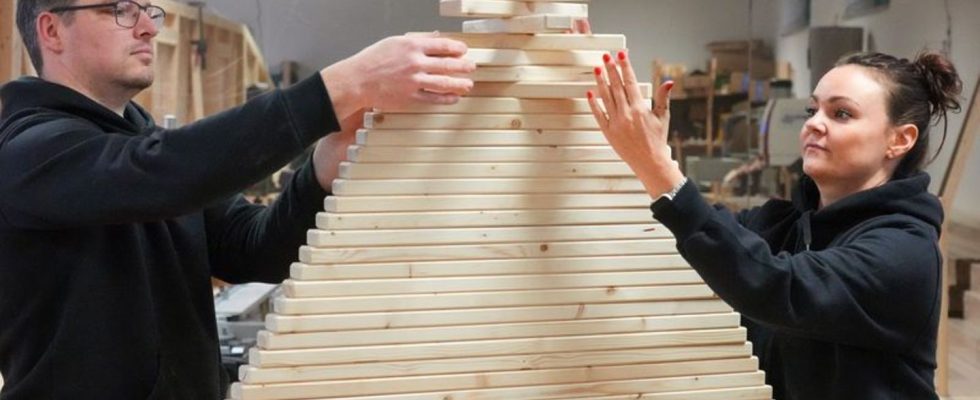A Christmas without a tree is unimaginable for many. But does it always have to be a “real” copy that is thrown away after just a few weeks?
They do not need needles and can be put up again every year for the holidays: wooden Christmas trees. They increasingly offer an alternative to the classic fir, also for reasons of sustainability. Manufacturers in various regions of Germany produce the trees by hand, such as Thilo Tolkmitt in Stahnsdorf, Brandenburg. His slatted trees consist of up to 90 individual parts that have to be assembled at home.
The principle is simple: slats of different sizes made of pine or spruce are placed on a stick. This is in turn attached to a stand. “You can set up the trees flat or twist them up,” explains Tolkmitt. He has drilled holes on the side of each slat so that decorations can be hung.
If the needles in the living room are annoying
He came up with the idea when the many needles on a Christmas tree in his living room bothered him. “I looked for ideas on Pinterest and built myself a wooden tree,” said the 41-year-old. Little by little, inquiries also came from friends. “My daughter then gave me the idea that I could also sell the trees,” says Tolkmitt.
Three years ago he and his cousin Ulrike Thunack finally started the small company “Franky Tree”, named after Thunack’s Cocker Spaniel Franky. “Business got off to a great start. Year after year we were able to double the number of units,” reports business economist Thunack.
The trees can be seen in the shop window of the workshop, but 99.9 percent of the business is done online. “The orders come from all over Germany, but also Austria and Switzerland,” says Thunack. Both private individuals and companies rely on the trees. “In offices, for example, it’s nice when you don’t find a tree corpse after the Christmas holidays,” says Thunack.
A risky business
“We experimented a lot and optimized the work steps,” says construction technician Tolkmitt, who gave up his job in the public service to produce trees. But the business is risky and a real thrill. “The sales period is only about six weeks. It is a niche product that is not exactly cheap. In addition, the price of wood has risen extremely,” says Thunack. The trees cost several hundred euros and are therefore significantly more than a classic Christmas tree.
There is also competition. Trees of the “Crosstree” brand come from the Black Forest, the “Dresden Tree” from Saxony and the “Tischler-Tanne” from Saarburg (Saarland). The Berlin production designer Merlin Ortner-Exss calls his model for putting together “The Wooden Tree”. With its curved branches and twigs and green color, it resembles natural trees a little more than the simpler picket trees.
And the Berlin wooden tree is reminiscent of trees from Lovi, a Finnish manufacturer. These are sold in Ahrensburg in Schleswig-Holstein. “Demand has been increasing for several years,” says Finnish Riikka Wartiainen, owner of Koti, a Nordic design shop. “It is a larger purchase, but the trees save space and are easy to care for,” adds employee Tanja Rohde.
Thomas Gottschalk celebrates with a folding fir tree
TV presenter Thomas Gottschalk announced in 2006 that he would celebrate Christmas with a folding fir tree: “I am completely satisfied with an artificial Christmas tree for environmental and economic reasons and because of the risk of fire,” he said in an interview. “The fir tree will last longer than me,” said Gottschalk.
The Nabu expert for resource policy Indra Enterlein points out that a wooden tree actually only replaces a Christmas tree if it is used for years, because: “A few trees have to have grown in order to be able to produce the wooden trees at all,” says the expert. She also recommends that you look for wood from sustainable management when purchasing – this can be recognized by a corresponding seal.
The blogger Alexandra Achenbach has written a book about how to celebrate Christmas as environmentally friendly as possible (“Zero Waste Christmas”, 2019). She is also a fan of wood alternatives, she says with regard to Christmas trees. But she prefers models that don’t “eat” any new material. “If you reuse the old slatted frame or an old piece of furniture or collect and craft found wood yourself instead of buying new, you not only save money. There is also an unbeatable feeling of self-efficacy, a wonderful ecological balance and a lot of fun,” says Achenbach.
Ulrike Thunack and Thilo Tolkmitt need new material for their trees. However, they support the reforestation project Viva la Wald from Potsdam. “For every Franky Tree sold, Viva la Wald plants a tree in Brandenburg,” says Thunack.

